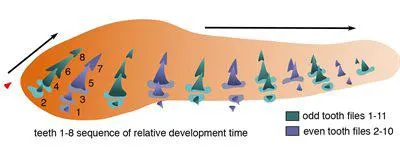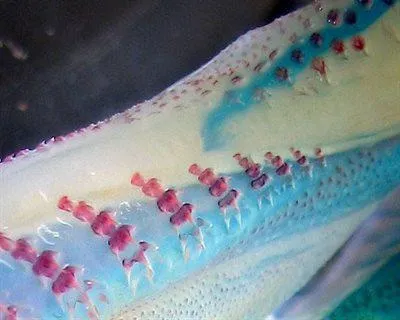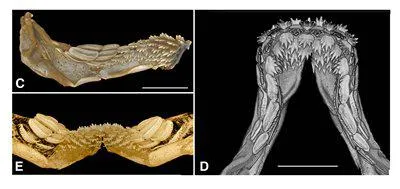09 March 2018
Journal of Anatomy article: Professor Meredith Smith
An article about the development and evolution of tooth renewal in neoselachian sharks as a model for transformation in chondrichthyan dentitions was published in Journal of Anatomy, 5 March 2018.

Professor Moya Meredith Smith (Tissue Engineering & Biophotonics Division at King’s) with researchers from the Department of Earth Sciences, Natural History Museum and the Department of Palaeontology, University of Vienna have published a research article in the Journal of Anatomy online on 5 March 2018.
The research article is about the dentitions of sharks that replace their teeth continuously throughout life in a regulated pattern where regeneration is common to all members of this group of jawed vertebrates and is inherited from the early days of their evolution.
Figure shows: left lower jaw of the Angel Shark with first embryonic developing tooth files in an alternate timed sequence of 1-8 but arranged in single file with gaps between them, later in the adult to occlude with upper jaw teeth between lower jaw ones.
This particular group of cartilaginous fish (as specified on a phylogeny of sharks and rays) can become specialized to make a cutting edge to their bite when all the teeth in the functional row erupt together as a knife-like blade. The article shows how this may have evolved by modification of an inherited developmental pattern, i.e. how the teeth are organized along the functional row to regenerate in a time and space order, that is regulated to erupt in a specific pattern.

Image shows: Hatchling of the frilled shark lower jaw at the back where tooth files are still developing with teeth stained for calcium as red over blue cartilage, in single file arrangement. Skin teeth are tiny and also in red, jaw symphysis is to the left and oral surface bottom.
The article proposes a developmental-evolutionary model to allow change from the inherited alternate pattern of replacement teeth timed to erupt alternately into one ordered as single replacement files that allows simultaneous eruption of all the teeth in one functional row at the jaw margins. This is a functional adaptation to form teeth locked together into an efficient cutting-blade.

Image shows: three views of produced as 3D renders of the hatchling Port Jackson shark.
The research group suggest that considerable plasticity of dental development allows this change from the inherited alternate arrangement of adjacent replacement tooth files to establish new dental morphologies in the adult.
Read the full article online at http://onlinelibrary.wiley.com/doi/10.1111/joa.12796/full

